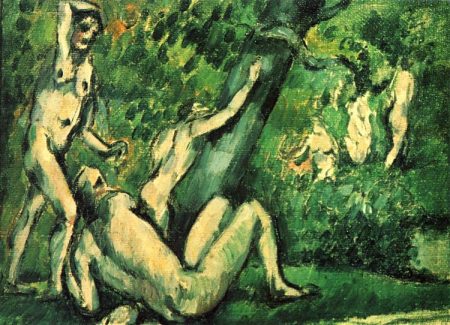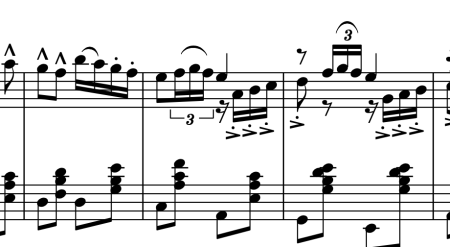
Cezanne: The Bathers (1877) [source]
I’m always interested by the problems thrown up by recording particular pieces of ballet repertoire: why are some solos so difficult to play, when they look like nothing at all on the surface? I’ve already written about this with reference to two solos from Swan Lake, Odette and Odile.
Now for another one from Act 3 of the ballet as most people know it these days, Prince Siegfried’s solo from the Black Swan pas de deux. Apart from all the problems I’ve mentioned in those posts, there is above all the fact that they are taken so slowly that you begin to lose all sense of flow and timing.
I’ve noticed in contrast to this that you can hold a tempo with rhythmic precision without ever needing a metronome when playing Bach (in the absence of ballet choreography, I should add) because the tempo holds itself by virtue of what you could call the system of its construction, just as the engineer Joseph Paxton was inspired by the extraordinary weight-bearing capacity of giant water lilies when he designed Crystal Palace. In music like the prelude in F BWV 856 (see below), the music seems to have its own web-like structures that hold it together.

I can’t help being reminded of something the anthropologist Tim Ingold says in Being Alive, that the term”network” in Actor Network Theory carries unfortunate contemporary connotations of instant connections between points “in a network”—the scare quotes because, as Ingold points out, in the original French coined by Bruno Latour, the term réseau
can refer just as well to netting as to network—to woven fabric, the tracery of lace, the plexus of the nervous system or the web of the spider. The lines of the spider’s web, for example, quite unlike those of the communications network, do not connect points or join things up. Secreted from the body of the spider as it moves, they are the lines along which it acts and perceives.
In other words—though the idea is much more an image or metaphor than something that can be explained like a fact—those quavers in the left hand provide a kind of structure for the semiquavers in the right, while the division of the quavers in the right help to “measure out” so to speak, the implicit tempo of the left, but the result is a kind of netting, a line, a flow, that is not about space between one note and the next, but is the texture, the line, the flow, the melody, the music. You barely have to think about metre, tempo, or even rhythmic accuracy—it plays itself, as musicians sometimes say.
In contrast to this, with the Tchaikovsky “Siegfried Solo” at the tempo it is usually played for the variation, a chasm opens up between one plucked oom in the left hand, and its related cha. It’s so slow and laboured that the melody in the right hand risks being as disjointed as Liz Truss’s notorious speech about cheese, in which she verbally punctuated the words “that. is. a. disgrace” with imaginary full-stops, as if she were reading a tweet that she didn’t understand.

Update 19/06/2023: In the paragraph that follows, I’m leaving in my mistakes of attribution. Adam Lopez, probably the most knowledgeable person about the Imperial repertoire that I’ve ever known, has corrected me in a comment to this post, which I’ll repeat here in case you never make it to the comments:
[T]he familiar variation for Siegfried that you discuss here was not added until the 1930’s by Vakhtang Chabukiani at the Kirov. I’m not sure how or when the habit of performing this particular variation spread to the west…or, perhaps the west started using it first and the habit spread east? Drigo’s 1895 edition of the score used “no. 5-3 Tempo di Valse” as the male variation (danced by Alexander Gorsky)
See comment by Adam Lopez on this post
It doesn’t help that this once sprightly, folksy, light violin solo from an Act I “pas de deux for Two Merrymakers” was transformed, in Drigo’s orchestration for the 1895 Petipa/Ivanov version, into a bombastic brassy principal male solo that usually has four sections at slightly different speeds, linked by subtle tenutos and ralls (Drigo can’t be held responsible for the tempo, of course). Similarly, the everything-but-the-kitchen-sink coda makes sense as a lot of drunken fun at a wedding for two merrymakers, but is a strain to take seriously as the most famous fouetté music in the world in in its new place in Act 3.
Of all ballet solos, Siegfried is the one that I find hardest to play in any convincing way, though I only notice how badly I’m doing it on the rare occasion that I’ve had to record it. It’s a litmus test for any rehearsal pianist, because there are so many ways to go wrong in it from an accompanying point of view, starting with the fact that you might not find the version you need at all—some productions use the violin solo for the first part, others rearrange it, others just play the whole thing loudly up the octave with triplets rather than trills, and just occasionally, you meet someone (as I did just once in more than 30 years) who wants the solo as it was originally written in Act 1. Matthew Bourne’s version is one of the few that uses Tchaikovsky’s original music from 1877 rather than the Drigo 1895 adaptation the 1930 Chabukiani music. The version below is the middle ground, the first eight bars being the Act 1 version transferred to clarinet, before moving up the octave and triplets instead of trills. To me, the solo looks quite different when it’s got the trills rather than brassy triplets where the cabrioles are: trills whisper sprezzatura, triplets shout LOOK AT MY CABRIOLES.
Once you’ve decided which score you need, then the first obstacle is the A of the anacrusis which you’re likely to whack out so that you have nothing left to give the “one” in the next bar. In fact, after a while, it seems like there isn’t a note in this solo that isn’t accented, but you started at 127 on the MIDI scale. Oh, and those triplets—they look so twiddly and fast, those triplet semiquavers, but you have to imagine that you’re trying to play them against two semiquavers in the left hand, and that those two semiquavers are subdivided mentally by demisemiquavers to keep the tempo stable. It’s almost as if you need to think of the triplets as being in a 3/4 bar all of their own. The temptation (or mine at least) is to play the F# early, which means that you have to spin out the triplet even longer. You look up, and see that your tempo is just a smidge faster than the dancer, and unlike the rasp of a low string note which has a kind of stretchy cushion of a beat to step on, the piano has marked the beat precisely, so you then have to measure your next chord to match the cadence of the dancer’s step with millisecond precision, which is even more difficult because your right hand is already leading off in its own tempo. with so much free space between beats to play in. For all these reasons, I think if I were auditioning a prospective pianist, I would ask them to play this, having first watched a few solos on YouTube for tempo. I am willing to bet that this is eventually a harder task than playing solos that look “difficult” on the page.
It occurred to me after I’d done yet another take of one phrase badly, that what would help pianists like me to find the right way to play it would be to rewrite it in the editorial style of Percy Grainger—with unconventional guidance in italics (“schoolmasterly, but ingratiating” or “hold back swingingly” or “like a colliery band at a festival after two pints, but not three”), phrase marks, slurs, tenutos, miniature notes, and “dished up for piano” at the end.
Why Cezanne’s bathers? Today is apparently the day that Swan Lake originally premiered in 1877. When I visited the Cezanne exhibition at the Tate Modern recently I suddenly noticed the date 1877 underneath one of the paintings, and was amazed that I could be looking at something that was created in the same year as Swan Lake. The comparison is particularly strange between, say, a painting like The Bathers and this rum-ti-tum marching tune.
References


jonathan, pitch-perfect grainger impersonation (as only a writer like you could do)–about the variation: you rehearsal pianists are responsible for so much more than tech class pianists, and so you have to be concerned with all those complexities and possibilities; but loud and at a steady under-tempo, that music serves at the end of any old advanced class when there’re just some guys who want to keep the accompanist overtime to practice tours
I should have added of course that playing it more or less unthinkingly for class (or indeed rehearsal) so often as you describe is one of the things that makes it harder to play it musically should you ever have to record it. Though to be honest, it doesn’t often sound very musical when an orchestra plays it, it just sounds like the end of class with a brass section.
Hello Jonathan! Long time no talk! Just wanted to tell you that the familiar variation for Siegfried that you discuss here was not added until the 1930’s by Vakhtang Chabukiani at the Kirov. I’m not sure how or when the habit of performing this particular variation spread to the west…or, perhaps the west started using it first and the habit spread east? Drigo’s 1895 edition of the score used “no. 5-3 Tempo di Valse” as the male variation (danced by Alexander Gorsky). —Adam
Hi Adam, long time indeed, I miss our chats a lot! Thank you so much for this information, once again, I’m astounded by my own ignorance and your encyclopaedic knowledge of this repertoire. And once again, it amazes me that something so many people take to be a “classic” turns out to be in fact less than a hundred years old and post-dates the original by decades.
Hello!
I’m constantly trying to figure out the provenance of variations and telling students (and teachers) ‘this isn’t original you know…’
So, the Siegfried variation,: is the music not arranged by Drigo (as the March edition of the piano score suggest)? Somebody later?
Michael
Hi Michael, sorry for the delay replying. I don’t want to swear on oath that I know the answer to this with any confidence, but that’s what I think is the case. As Adam Lopez pointed out to me, Drigo used the waltz variation for Siegfried, and just cut the pas de deux at the point where the A major variation would have started. You can see this from the Langer piano score which dates from the Drigo production. I’m going to ask around about this, because what I thought was the case was that the Chabukiani variation uses the original Tchaikovsky score from near the end where it gets loud, but I’m not 100% convinced about that either.